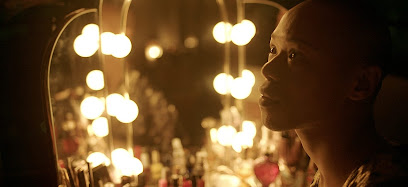Movie Review - Two Eyes (Outfest 2020)
Fine's film is different from Soderbergh and even Iñárritu's films because his main characters aren't all contemporaries. It's more like This Is Us because in that series, one sees three stories in the first episode but don't realize until the end that they're all taking place in different time periods, or even after the different time period is revealed, it's not until the end that one realizes that the characters in the stories have a familial connection. Fine's film essentially does the same thing. The exception is that his film announces the fact that the three stories are occurring in three, different time periods, the farthest gap being 100 years. However, the question is what's the familial connection. Yet, that twist, as it were, almost doesn't matter because the three stories obviously have strong thematic connections. Through each protagonist, they are able to explore true parts of themselves that they haven't before, often through the love of another person. As with Any Day Now, those explorations and even loving relationships sometimes end in tragedy. However, I would say that Fine's film this time ultimately has a more hopeful conclusion than Any Day Now or the ending isn't as bittersweet.
Ryan Cassata starts off the film as Jalin, a teenager living in Wyoming in 2020. At the beginning, she is playing the guitar and singing a song to a girl. Not much is known about Jalin, except Jalin could be either a boy or a girl. It's not clear until Jalin says there is a preference for he and him as the chosen pronouns. This stated preference comes after what is assumed to be a suicide attempt that results in Jalin being hospitalized and then taken to a shelter for LGBT youth in crisis, either being homeless, suicidal or otherwise. Jalin is apprehensive and mostly quiet, but he meets the person who runs the shelter, a nonbinary transgender person named Andrea whose pronouns are she and they. We don't get too many specifics about Jalin's life. Jalin could be transgender or Jalin could be simply gender nonconforming or nonbinary. It's never delved. However, we do get more information about Andrea who becomes a matriarchal figure akin to the character of Anna Madrigal from Tales of the City.Benjamin Rigby (Ford v Ferrari and Alien: Convenant) co-stars as Dihlon McCarthy, a man living in Montana in 1868. He rides a horse and looks like a cowboy or one who could be Clint Eastwood's son. Yet, it's revealed he's not a gunslinger or even that much of the rugged type. He's an artist, a painter from either England or Australia, who has come to this area to paint the people and the places, or as he says to find his muse. He basically is a tourist and his guide is a Native American or indigenous person named Jacy, played by Kiowa Gordon (Roswell, New Mexico and The Twilight Saga: New Moon).
As I said in a previous review for Outfest, that of Anna Kerrigan's Cowboys (2020), the success of Brokeback Mountain (2005) didn't really shepherd or herald films that took the Western genre and used it to tell queer stories or infuse queer characters into that time period. However, Fine in this segment of his film is able to do that. As most people know, LGBTQ people weren't invented in the 20th century, they've existed all throughout time. Fine's film gives us a clear example of that, but not just with the cliché idea of a closeted, white man. Through Dihlon's story, we are introduced to the Crow tribe of indigenous people. In the Crow tribe, they have what's called "batée," which is a term that could refer to a gay man or even a trans-woman. Jacy describes it as a person who is both male and female, a nonbinary view that native people had for centuries, certainly prior to white colonists arriving. I liked that nonbinary, Native American character. I wish we got more of that person in terms of characterization.Uly Schlesinger (Divorce and The Sinner) also co-stars as Gabryal, a teen kid living in Barstow, California, in 1979. He's an aspiring photographer, as he carries a film camera everywhere he goes. He also likes music and occasionally performs in a choir. Yet, it's not his true passion. Photography is. His life changes when he meets an exchange student from England, a black girl named Alasen, played by Jessica Allain (The Laundromat). Alasen recognizes that Gabryal is smitten with her, so one day she gets him to skip school and take a trip to Los Angeles to meet a friend and musician. It's there and through this musician that Gabryal's perceptions about his identity are opened up.
Nakhane Touré (The Wound) also co-stars as Thandi, the aforementioned friend and musician in Los Angeles whom Alasen and Gabryal visit. Nakhane is a musician in real life from South Africa who actually performs in the film. Nakhane does two songs that are covers of songs from black transgender musician, Jackie Shane, whose songs were originally released in 1969, that of "New Way of Lovin" and "Cruel Cruel World." Shane's version of her songs were more uptempo and more hard edged. Nakhane's version is more haunting and heartbreaking, more acoustic and less of a rock music sound.
What Fine does is also include songs from Nakhane's previous albums that he recorded years prior. Those songs and Nakhane's voice are some of the most beautiful things one will ever hear. If nothing else, check out his previous records, including You Will Not Die (2019) and Brave Confusion (2013). The standout tracks though are Nakhane's "Violent Measures" and "Utopia," which is played over the end credits, but all his songs are superb.Not Rated but contains language and sexual situations.
Running Time: 1 hr. and 34 mins.
Streamed through OutfestNow.








Komentar
Posting Komentar